From the ordinary to the extraordinary: how a simple train ride led to a breakthrough discovery in sustainable crop research

The Kepinski lab, based in the School of Biology, reveal new research into the angles of plant roots.
It was on an ordinary commute from work when Professor Stefan Kepinski, Head of the School of Biology and Associate Director of the Global Food and Environment Institute (GFEI) at University of Leeds, spotted something out of the train window – a detail that could unlock big potential in building global food security.
“Looking at the tree silhouettes, I was struck by how different species could be identified largely by the angle of their branches”, said Professor Kepinksi.
“This observation triggered a series of thoughts: that the differences were genetic; that most plant life, both above - and below-ground, exists on non-vertical branches, because non-vertical growth is so crucial to resource capture; and that little is known about the underlying biology.”
It was this thinking which led to pioneering research into understanding the underlying molecular regulation of root architecture – specifically the angle at which roots grow – involving a range of academics including Dr Suruchi Roychoudhry, Senior Research Fellow in Plant Molecular Biology in the School of Biology.
As part of their initial research, they quickly came across what scientists call the gravitropic set-point angle (GSA) concept – the angle at which a branch grows in relation to gravity.
Their research showed that an anti-gravity mechanism – also known as the anti-gravitropic offset (AGO) - counteracts the plant’s underlying response to gravity to allow growth at non-vertical angles.
It also shed a light on the importance of auxin – a type of plant hormone that controls cell lengthening and the formation of auxin gradients that steer the direction of root and shoot branch growth.
While this was a breakthrough moment in understanding how plant roots and branches respond to gravity, there were also many unanswered questions including can we demonstrate these proposed auxin gradients and the molecular mechanisms that regulate them?
To elucidate the details of the molecular mechanism, it is necessary to detect subtle changes in the localization of PIN proteins (proteins which transport auxin through plants), which was expected to be a very difficult analysis. The authors took on the challenge and have conducted a very high-quality study.
In the paper, PIN phosphoregulation drives gravity dependent non-vertical growth in Arabidopsis roots funded by the Biotechnology and Biological Sciences Research Council, the Kepinski lab has taken one step further in answering that question, proving that a certain type of PIN protein – PIN7 - is a better facilitator of upward growth in the roots of plant Arabidopsis – a type of cress plant.
They also found that auxin makes rooting angles more vertical by stabilising another significant protein – RCN1, found in gravity sensing root cells.
“In our latest study, we used biochemical, genetic and live cell imaging approaches using a specially designed vertical microscope to investigate gravity-dependent changes in these proteins in real time,” explains Dr Roychoudhry.
“By identifying the molecular basis of gravity-dependent non-vertical growth, our work could pave the way for exciting new tools for the manipulation of root systems.
This has huge potential to reduce reliance on environmentally damaging synthetic fertilizer and irrigation, thereby increasing the sustainability of crop production.

Image description: The white arrowhead highlights a PIN7 protein at the edges of gravity sensing cells of a lateral root.
The challenge of building a food secure world
Over the coming decades, a changing climate, growing global population, increasing food prices and environmental stressors will have significant yet uncertain impacts on global food security.
Alongside these challenges, the ‘Achieving zero hunger by 2030’ challenge set out by the United Nations Sustainable Development Goals requires the doubling of agricultural productivity to meet the needs of a global population.
A number of studies have suggested that crop varieties with root architecture modified to include a small number of steeply growing roots have increased yield performances, particularly in lower input and drought prone areas, due to their enhanced capacity to efficiently forage yield limiting water and nitrogen from deeper soil.
This is significant for a very important reason. Nitrogen is critical to plant growth and reproduction and as a result, nitrogen-based fertilisers are widespread in farming practice. They’re also powerful polluters of nitrous oxide, a dangerous greenhouse gas. A study in 2022 shows that the supply chain for synthetic nitrogen-based fertiliser was responsible for up to 10.6% of agricultural emissions and 2.1% of global greenhouse gas emissions.
The promising news is that research from the Kepinski lab suggests there’s a strong possibility that, with further research, proteins that drive plant growth can be engineered to drive steeper, deeper rooting to improve the way plants capture their nutrients, including nitrogen. The more efficiently crops can do this, the richer – and more sustainable – the crop.
Professor Kepinski added:
“Our initial breakthrough — root and shoot branches grow non-vertically because the underlying gravitropic response is counteracted by an offset mechanism — was made using nineteenth century techniques.
It took twenty-first century microscopes and cell biology to reveal the nature of this offset mechanism.
Header image: Tomasz Filipek from Unsplash




